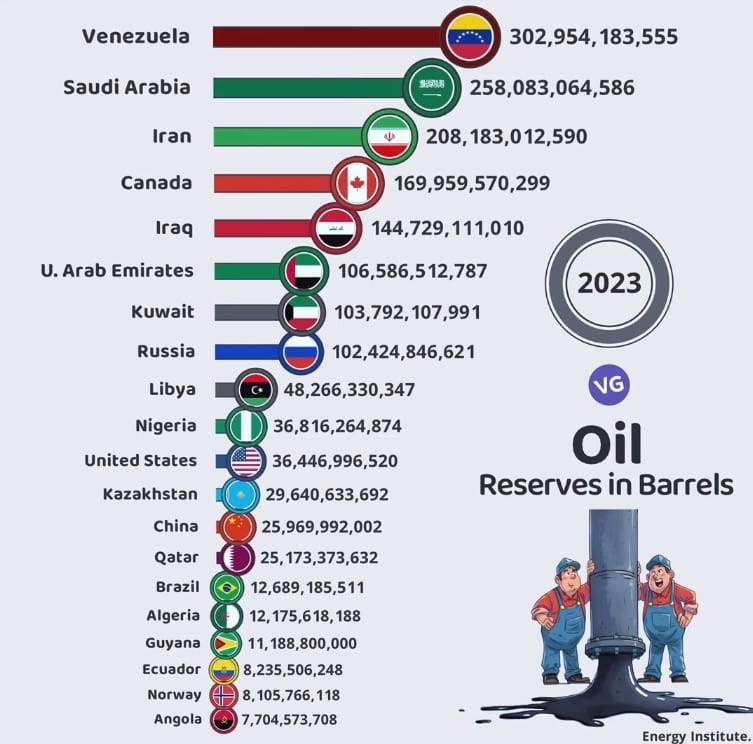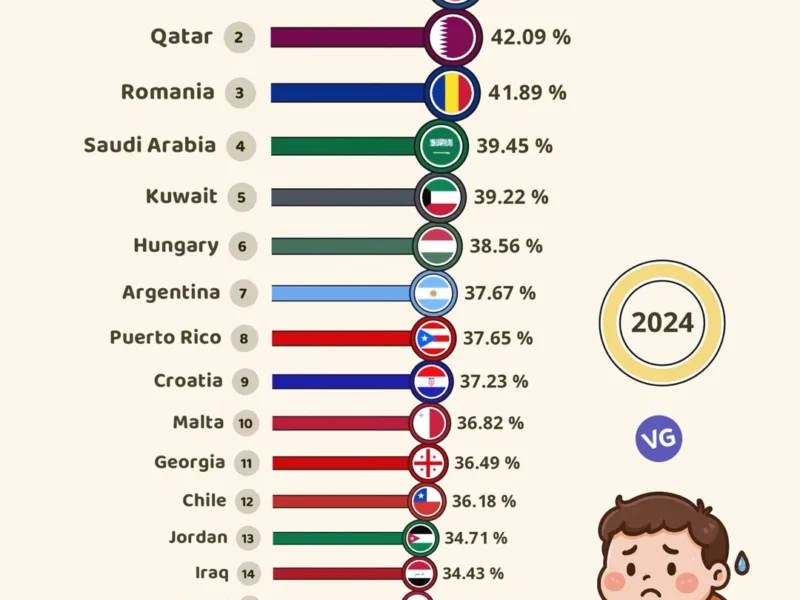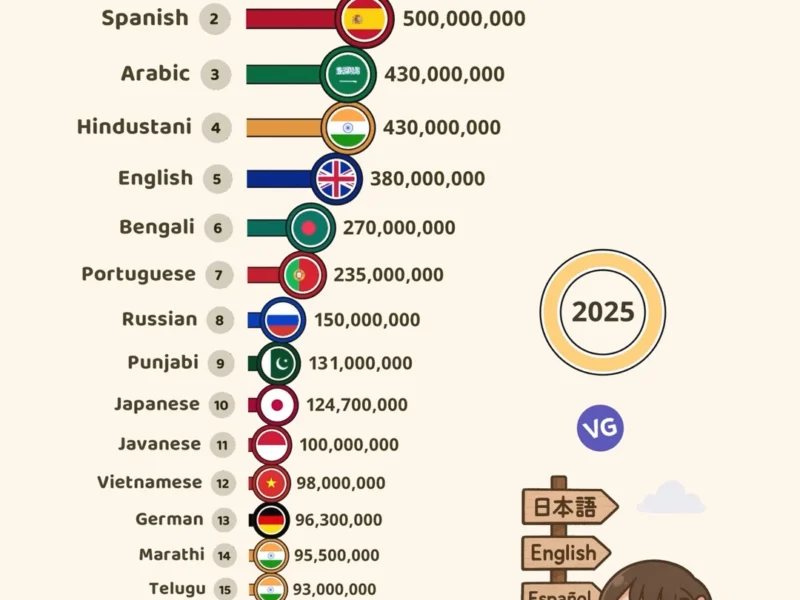The U.S. Energy Information Administration (EIA) says Venezuela has the most oil in the world. They have over 300 billion barrels of proven oil12. But, it’s hard for Venezuela to use this oil because of political issues, economic problems, and U.S. sanctions. Because of this, they’ve made less oil in the last few years, making about 600,000 to 700,000 barrels a day in 2022.
Biggest Oil Reserve in The World 2023
| Country | Flag | Oil Reserves (Barrels) |
|---|---|---|
| Venezuela | 🇻🇪 | 302,954,183,555 |
| Saudi Arabia | 🇸🇦 | 258,083,064,586 |
| Iran | 🇮🇷 | 208,183,012,590 |
| Canada | 🇨🇦 | 169,959,570,299 |
| Iraq | 🇮🇶 | 144,729,111,010 |
| U. Arab Emirates | 🇦🇪 | 106,586,512,787 |
| Kuwait | 🇰🇼 | 103,792,107,991 |
| Russia | 🇷🇺 | 102,424,846,621 |
| Libya | 🇱🇾 | 48,266,330,347 |
| Nigeria | 🇳🇬 | 36,816,264,874 |
| United States | 🇺🇸 | 36,446,996,520 |
| Kazakhstan | 🇰🇿 | 29,640,633,692 |
| China | 🇨🇳 | 25,969,992,002 |
| Qatar | 🇶🇦 | 25,173,373,632 |
| Brazil | 🇧🇷 | 12,689,185,511 |
| Algeria | 🇩🇿 | 12,175,618,188 |
| Guyana | 🇬🇾 | 11,188,800,000 |
| Ecuador | 🇪🇨 | 8,235,506,248 |
| Norway | 🇳🇴 | 8,105,766,118 |
| Angola | 🇦🇴 | 7,704,573,708 |
Key Takeaways
- Venezuela has the world’s largest proven oil reserves, estimated at over 300 billion barrels.
- Venezuela’s oil production has declined significantly in recent years due to political, economic, and sanctions-related challenges.
- Saudi Arabia has the second-largest oil reserves, with over 266 billion barrels.
- Canada, Iran, and Iraq are also among the countries with the largest oil reserves globally.
- The United States, despite being a major oil producer, ranks only ninth in terms of total available oil reserves.
Venezuela: The Country with the World’s Largest Oil Reserves
Venezuela has the biggest oil reserves in the world, over 300 billion barrels34. This huge resource could greatly improve the country’s economy. But, the oil industry in Venezuela faces big challenges that stop it from using this asset well.
Oil Reserves in Barrels by Country (2023)
Source: Energy Institute, 2023
Proven Reserves and Production Struggles
By 2015, Venezuela had about 300.9 billion barrels of confirmed oil reserves4. This was even more than Saudi Arabia’s reserves in 20094. But, oil production fell from over 3 million barrels a day in the early 2000s to 600,000-700,000 bpd in 20223. This big drop is mainly because of lack of investment, poor management, and U.S. sanctions.
Economic and Political Challenges
Venezuela’s economic and political issues have hurt its oil industry. The first oil price drop in the 2000s hurt the economy, and U.S. sanctions made things worse4. In 2022, Venezuela only exported about 600,000 bpd of oil, much less than before3. Corruption, poor management, and power fights have also hurt the oil industry.
Even with a lot of oil, Venezuela can’t turn it into wealth and stability. Political and economic problems have made it hard to use its huge oil reserves. This leaves the Venezuelan people facing big challenges.
Saudi Arabia: The Second-Largest Oil Reserve
Saudi Arabia is the world’s second-largest oil producer and the biggest member of OPEC. It has an oil reserve of about 268 billion barrels. This is over 50 years of oil at current rates5. These reserves make up more than one-fifth of the world’s conventional oil reserves5. The kingdom’s oil production has grown from 11 million barrels a day in 2008 to 12.5 million barrels a day by 20095.
Proven Reserves and Production Capacity
Saudi Arabia’s oil reserves have been closely watched. In 2019, an independent check found the country’s proved reserves at 270 billion barrels, matching Saudi claims5. This is much higher than Venezuela’s 300 billion barrels, mostly heavy crude oil5. From 2005 to 2013, Saudi Arabia produced 9.20 million barrels of crude oil and lease condensate a day5.
Recently, Aramco produced an average of 13.6 million barrels of hydrocarbons a day in 20226. The company made a net income of SAR 604.0 billion ($161.1 billion) in 20226.
Future Expansion Plans
Saudi Arabia plans to grow its oil production even more. It wants to increase capacity from 12 million barrels a day to 13 million by 20275. This move is part of its strategy to stay a leader in the global oil market and be a key OPEC member.
In 2022, Aramco and TotalEnergies made a deal to invest in a new petrochemical complex in Saudi Arabia6. Aramco also set up a $1.5 billion fund for green tech investments6. The Jafurah contracts were given out, with plans for $68 billion in spending over 10 years6.
“Saudi Arabia’s proven oil reserves have been the subject of ongoing scrutiny and analysis, with recent independent evaluations confirming the country’s massive reserves.”
Iran: A Major Oil Reserve Facing Sanctions
Iran has some of the biggest oil reserves in the world, with the fourth-largest at 157 billion barrels7. But, the U.S. sanctions in 2018 hit the oil industry hard. Now, Iran exports less than 760,000 barrels a day, as per OPEC data7.
Even with sanctions, Iran has slowly upped its oil exports, reaching over 1.13 million bpd in late 20228. They plan to increase oil production by about 450,000 b/d through domestic efforts since 20198.
The sanctions have really hurt Iran’s oil and gas sector, leading to less investment. What was once about $18 billion in the 1990s dropped to $3 billion by 20177. Yet, Iran remains key in the global energy scene with its huge reserves and big production goals.
| Key Figures | Data |
|---|---|
| Proven Oil Reserves | 157 billion barrels7 |
| Oil Exports (2022) | 760,000 barrels per day7 |
| Oil Exports (Late 2022) | 1.13 million barrels per day8 |
| Planned Production Capacity Increase | 450,000 barrels per day8 |
| Annual Upstream Investment (1990s) | $18 billion7 |
| Annual Upstream Investment (Early 2010s) | $7 billion7 |
| Annual Upstream Investment (Since 2017) | $3 billion7 |
Sanctions have really hit Iran’s oil and gas hard, causing less investment7. But, Iran still plays a big role in the global energy world with its vast reserves and plans for more production.
Canada: A Powerhouse of Oil Sands Reserves
Canada leads the world in oil reserves, with about 171 billion barrels of crude oil9. Most of these, around 166.3 billion barrels, are in oil sands in Alberta10. It’s the fourth-biggest oil producer, producing over 5 million barrels daily in 2022, a new record9.
Oil Sands Distribution and Production
Alberta’s oil sands hold 1.7 to 2.5 trillion barrels of bitumen, the biggest oil reserve globally10. Canada’s oil sands are second only to Saudi Arabia in recoverable oil10. At current rates, Alberta’s oil sands could meet Canada’s energy needs for over 500 years or the world’s for up to 15 years10. Oil sands make up 39% of Canada’s oil production10. Production is set to jump from 1.3 million barrels daily to 3 million by 202010.
Environmental Concerns and Industry Growth
Despite efforts to reduce the industry’s carbon footprint, Canada’s oil production keeps rising, driven by global demand9. Extracting and processing oil sands uses a lot of energy and has a bigger carbon footprint than traditional oil9. The government has set policies to lessen the industry’s environmental impact, like carbon pricing and emissions targets9. Yet, the industry keeps growing, hitting record levels in 2022 as oil demand stays strong9. Finding a balance between the oil industry’s economic benefits and environmental impact is a big challenge for Canada9.
Over the next 10 years, over $60 billion will be invested in oil sands development10. The Alberta Energy and Utilities Board predicts oil sands will be Alberta’s main crude oil source in a decade, replacing conventional crude stocks10.
| Country | Oil Reserves (million barrels) | Oil Production (million barrels per day) |
|---|---|---|
| Canada | 171,0009 | 5.09 |
| Saudi Arabia | 266,500 | 11.0 |
| Venezuela | 304,000 | 2.1 |
“Canada has the potential to become a leading force in energy and resources, contributing to the development of technologies that create high-paying jobs and enhance environmental performance worldwide.”
Iraq: OPEC’s Number-Two Producer with Ambitious Plans
Iraq is a big name in the oil world, with huge oil reserves, ranking fifth globally with 145 billion barrels11. It also has about 215 billion barrels of undiscovered oil, says the Oil Ministry11. Iraq’s total recoverable oil and gas liquids are estimated at 246 billion barrels by the IEA11.
Right now, Iraq produces around 4.5 million barrels of oil daily, with 3.4 million going to other countries11. The oil committee in Iraq wants to boost production to over 5 million barrels a day. They aim for as much as 13 million barrels a day in the future11. Experts think Iraq could hit 6.3 million barrels a day in five years with the right investments11.
Proven Reserves and Current Production
Iraq has 143 billion barrels of proven oil, which is 18% of the Middle East’s and nearly 9% of the world’s reserves12. From 2011 to 2015, Iraq’s oil production jumped from 2.6 million to almost 4.1 million barrels a day12.
But, Iraq’s oil sector has faced big challenges. Political issues, infrastructure problems, and the fight against ISIL have slowed it down. Iraq lost over $14 billion from 2011 to 2014 due to payments to oil companies11. Big Western oil companies are also hesitant to invest because of corruption and unstable rules11.
Despite these challenges, Iraq is still a key player in the oil market. With its big reserves and plans to increase production, it could greatly affect OPEC and the world’s energy scene1112.
Kuwait: A Small Nation with Big Oil Ambitions
Kuwait is a small country but a big name in oil. It has about 101.5 billion barrels of oil under its ground13. This makes it a key player in the world’s energy market. The country pumps out 2.6 million barrels of oil every day. It sends about 2.3 million barrels to other countries13. Kuwait has big dreams for its oil wealth.
Proven Reserves and Export Figures
Kuwait sits on 102 billion barrels of proven oil, which is about 6 percent of the world’s oil14. It also has 5 billion barrels in the Neutral Zone with Saudi Arabia, making a total of 104 billion barrels14. In 2012, Kuwait produced around 2.8 million barrels of oil daily14.
That year, Kuwait made about $75 billion from oil exports, which was half of its total economy and 70 percent of its exports14. By 2030, Kuwait plans to increase its oil production to 4 million barrels a day13. This shows Kuwait’s belief in the future of oil.
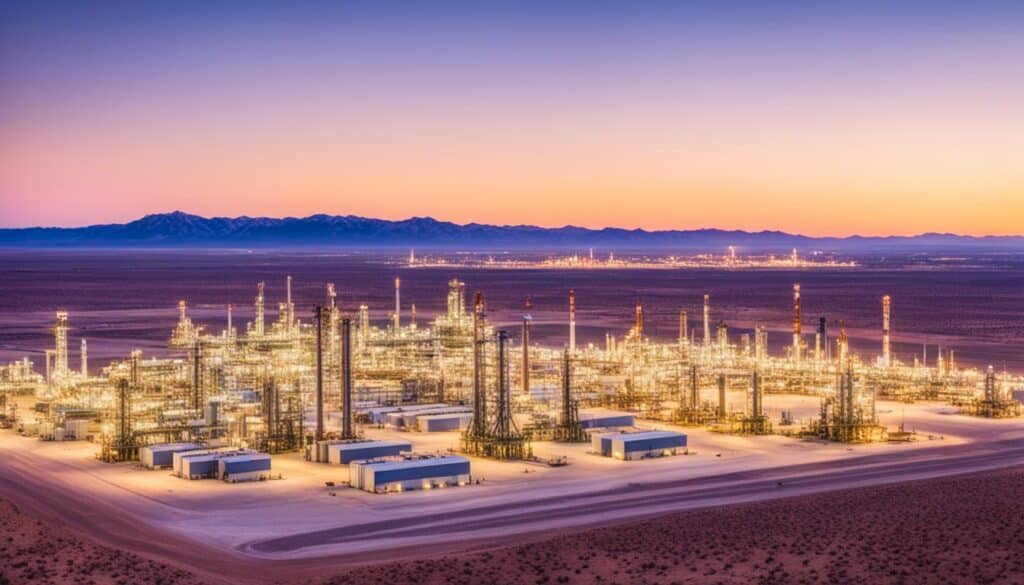
“Kuwait, a small OPEC nation, has proven oil reserves of around 101.5 billion barrels, making it a significant player in the global energy landscape.”
United Arab Emirates: Oil Wealth Fueling Diversification
The United Arab Emirates (UAE) is OPEC’s third-largest oil producer. It has 111 billion barrels of crude oil reserves15 and produces 2.9 million barrels of oil daily15. Despite oil and gas making up only 30 percent of its economy16, the UAE is diversifying its economy thanks to its oil wealth.
Proven Reserves and Production Levels
The UAE has huge oil and gas reserves, including 290 trillion cubic feet of proven natural gas15. ADNOC aims to increase production to 5 million barrels per day by 203017, up from 3.2 million now17. ADNOC is investing in upgrading its operations and expanding refining and petrochemicals as part of its 2030 Strategy17.
Diversifying the Economy
The UAE is moving beyond oil and gas to grow its economy. It’s becoming a top spot for luxury travel and entertainment16. The country plans to have 14GW of clean power by 2030, using nuclear and renewable energy16. It also aims to cut its carbon intensity by 25% in the next decade16.
The UAE is also investing in new technologies to become a high-tech hub. It’s working on a Hydrogen Leadership Roadmap to be a top hydrogen exporter16. The Abu Dhabi Hydrogen Alliance is focusing on green and blue hydrogen in new markets16.
The UAE is also focusing on reducing its environmental impact. It plans to plant 100 million mangroves by 203016. It has built a carbon capture facility that captures 800,000 tons of carbon dioxide, with plans to expand it six-fold by 203016. The UAE is the only oil company to get all its grid electricity from zero-carbon sources16.
The UAE is working hard to diversify its economy and lessen its environmental impact. It’s using its oil wealth to invest in renewable energy, new technologies, and green projects. This makes the UAE a leader in moving to a sustainable future.
Russia: A Major Oil Producer and Exporter
Russia is a key player in the oil world, with huge reserves and production. It has about 80 billion barrels of proven crude oil18. Before the Ukraine invasion and Western sanctions, Russia produced over 11 million barrels of oil daily, including condensates18.
After the sanctions, Russia cut its production to around 9.4 million barrels per day, not counting condensates18. Still, it’s a big oil producer and exporter. By the end of 2022, its oil and fuel exports were back to pre-war levels18.
Proven Reserves and Production Cuts
Russia’s oil production and exports are vital to the global energy market. In 2022, it made up 9.14% of the world’s oil exports, worth $133 billion19. It produced 10.13 million barrels daily, which is 10% of the world’s oil19. Even with cuts, Russia’s oil industry is still a big deal worldwide.
The sanctions led to big changes in Russia’s oil exports. But, it’s still a big supplier. About 60% of its oil goes to OECD Europe, and 20% to China18. It also sends oil and products to Belarus, Romania, Bulgaria, and other FSU countries18.
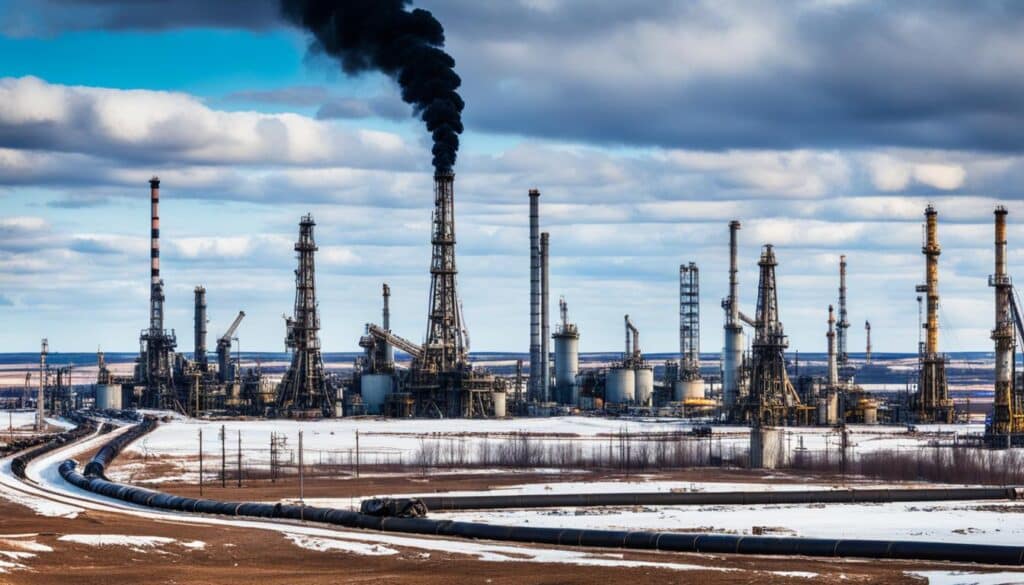
“Even with these production cuts, Russia remains a major oil producer and exporter, with its crude and fuel exports returning to pre-war levels by the end of 2022.”
The United States: Shale Oil Reshaping the Landscape
The United States has become a key player in the global energy scene. This is thanks to a big increase in shale oil production20. Now, tight oil makes up 36% of the country’s crude oil production20. This has changed the energy picture in the U.S. and cut down on oil imports from other countries20. The oil and gas sector added 169,000 jobs between 2010 and 201220. This shows how important this energy boom is for the economy.
Proven Reserves and Shale Oil Production
The U.S. has huge oil reserves, estimated at 48.3 billion barrels20. But shale oil has really changed the game. The country now leads in dry natural gas production, with 40% coming from shale20. Three major shale areas in the U.S. produce over 70% of all oil20. This shale oil boom has made the U.S. the biggest crude oil producer in the world21, expected to beat Saudi Arabia and Russia by 201721.
This energy shift is big news. The U.S. is expected to spend less on oil imports, from $335 billion in 2008 to $160 billion in 202021. This move towards energy self-sufficiency is a big deal. Also, the U.S. is now importing less oil, with imports making up just 27% of its oil use, the lowest since 198520.
The shale oil boom has big economic effects too. The oil and gas industry added 1.6% to the U.S. GDP in 201120. As the U.S. keeps increasing shale oil production, it’s set to start exporting energy by 203021. This will make the U.S. even more important in the global energy scene.
The U.S. becoming a big oil and gas producer has also changed the world stage. China is expected to take over as the top oil importer in 201721. The U.S. will start exporting liquefied natural gas (LNG) to Europe and Asia soon21. This change shows the U.S. is gaining more power in the global energy market.
“The United States has become the top oil and gas producer in the world due to the shale revolution22. US energy policies have shifted from scarcity to abundance due to increased energy production.”22
As the U.S. keeps using its shale oil reserves, its energy independence and global influence will grow. This will change the global energy scene for the future.
biggest reserve of oil in the world
Venezuela is now the top country with the biggest oil reserve globally. It has about 303.22 billion barrels of proven oil, the most in the world23. This makes Venezuela a key player in the global oil market, with a big impact on energy supplies.
But, Venezuela’s oil riches haven’t made the country wealthy. Political issues, economic troubles, and U.S. sanctions have hit its oil production and exports hard24. This has let countries like Saudi Arabia, Iran, Canada, and Iraq take a bigger role in the oil market.
| Country | Oil Reserves (Billion Barrels) |
|---|---|
| Venezuela | 303.2223 |
| Saudi Arabia | 267.1923 |
| Iran | 208.6023 |
| Canada | 163.6323 |
| Iraq | 145.0223 |
| United Arab Emirates | 113.0023 |
| Kuwait | 101.5023 |
| Russia | 80.0023 |
| United States | 55.2523 |
| Libya | 48.3623 |
Venezuela has the biggest oil reserve, but how well it can use it matters a lot24. Even with the most reserves, Venezuela faces big challenges. This lets other major oil producers lead in the global energy market.
The world is still figuring out the complex energy landscape. Countries with the biggest oil reserves will keep being watched closely by policymakers, investors, and energy users24.
Conclusion
A few countries hold most of the global oil reserves, like Venezuela, Saudi Arabia, Iran, Canada, and Iraq25. These countries face big challenges that affect how much oil they can use25. The demand for oil is still high, but the oil industry‘s future will change with renewable energy, new fuel sources, and environmental concerns25.
The countries with the most oil will be key in the global energy scene25. By 2026, we expect oil demand to hit 105 million barrels a day25. Until 2032, demand will stay above 100 million bpd25. These countries will be crucial in meeting the world’s energy needs.
The shift to renewable energy and electric vehicles will change the future of oil production25. As the world looks to reduce oil’s environmental impact, these leading oil producers must adapt and diversify25. They need to stay relevant in the changing energy world.
FAQ
What country has the biggest reserve of oil in the world?
Venezuela has the largest proven oil reserves, over 300 billion barrels, according to the U.S. Energy Information Administration (EIA).
Which countries have the largest oil reserves in the world?
The top countries with the biggest oil reserves are:
1. Venezuela (over 300 billion barrels)
2. Saudi Arabia (around 267 billion barrels)
3. Iran (208.6 billion barrels)
4. Canada (171 billion barrels)
5. Iraq (145 billion barrels)
How has Venezuela’s oil industry been impacted by political and economic challenges?
Despite having vast oil reserves, Venezuela struggles to use them fully. Political instability, economic crisis, and U.S. sanctions have hit hard. Now, it produces only 600,000 to 700,000 barrels per day, down from before.
What are Saudi Arabia’s plans for expanding its oil production capacity?
Saudi Arabia plans to boost its production from 12 million barrels per day to 13 million by 2027. This move aims to keep Saudi Arabia leading in the global oil market.
How have U.S. sanctions impacted Iran’s oil industry?
U.S. sanctions in 2018 hit Iran’s oil hard, cutting exports to just over 760,000 barrels per day in 2022. Yet, Iran has slowly increased exports, reaching over 1.13 million bpd by late 2022.
What are the environmental concerns surrounding Canada’s oil sands industry?
Canada’s oil sands are energy-intensive and have a big carbon footprint. The government is working to reduce the industry’s environmental impact. But, the industry keeps growing due to strong global demand.
What are Iraq’s plans to boost its oil production?
Iraq aims to increase its oil output despite past challenges. It wants to match Saudi Arabia’s production levels, but faces political and infrastructure hurdles.
How has Kuwait’s oil wealth enabled it to diversify its economy?
Kuwait plans to increase its oil production to 4 million barrels per day by 2030. This shows Kuwait’s confidence in oil’s future demand.
How has the United Arab Emirates’ oil wealth been used to diversify its economy?
The UAE uses its oil wealth to diversify its economy. It’s now a top luxury tourism spot and aims to be a high-tech hub. This is all funded by its oil revenues.
How has Russia’s oil production been impacted by the Ukraine invasion and subsequent Western sanctions?
Russia cut production due to sanctions, now producing around 9.4 million barrels per day. Despite this, it remains a key oil producer and exporter, with exports back to pre-war levels by late 2022.
How has the rise of shale oil production transformed the United States’ energy landscape?
The U.S. is now the top crude oil producer, thanks to shale oil growth. Shale oil has become crucial to the U.S. energy scene, despite not being included in the EIA’s reserves.
Source Links
- Oil Reserves by Country – Worldometer – https://www.worldometers.info/oil/oil-reserves-by-country/
- Top 10 Countries With Largest Oil Reserves In World – https://bestdiplomats.org/largest-oil-reserves-by-country/
- Top 10 Countries With Largest Oil Reserves | OilPrice.com – https://oilprice.com/Energy/Crude-Oil/Top-10-Countries-With-Largest-Oil-Reserves.html
- Oil reserves in Venezuela – https://en.wikipedia.org/wiki/Oil_reserves_in_Venezuela
- Oil reserves in Saudi Arabia – https://en.wikipedia.org/wiki/Oil_reserves_in_Saudi_Arabia
- Saudi Arabia – Oil Gas & Petrochemicals – https://www.trade.gov/country-commercial-guides/saudi-arabia-oil-gas-petrochemicals
- How Iran loses in joint oil and gas fields to neighbors? – https://www.iranintl.com/en/202407135157
- Charts, Graphs, and Maps – https://www.eia.gov/international/content/analysis/countries_long/Iran/pdf/iran_exe.pdf
- Portrait of an energy powerhouse: Canada – https://policyoptions.irpp.org/fr/magazines/from-climate-change-to-clean-energy/portrait-of-an-energy-powerhouse-canada/
- PDF – https://open.alberta.ca/dataset/d5a7fec7-6e37-431c-9f33-eb98510c65e4/resource/eb20740d-d1bc-4e60-b441-99f6c84998d8/download/2016-oil-sands-discovery-centre-osdc-facts-about-albertas-oil-sands-and-its-industry.pdf
- Iraq Takes First Step Towards Becoming The World’s Biggest Oil Producer | OilPrice.com – https://oilprice.com/Energy/Crude-Oil/Iraq-Takes-First-Step-Towards-Becoming-The-Worlds-Biggest-Oil-Producer.html
- Iraq Energy Profile: OPEC’s Second-Largest Crude Oil Producer – Analysis – https://www.eurasiareview.com/28042016-iraq-energy-profile-opecs-second-largest-crude-oil-producer-analysis/
- 15 Countries with the Largest Proven Oil Reserves in the World – https://finance.yahoo.com/news/15-countries-largest-proven-oil-154856233.html
- PDF – https://www.europarl.europa.eu/meetdocs/2009_2014/documents/darp/dv/darp20140213_11_/darp20140213_11_en.pdf
- No title found – https://www.eia.gov/international/content/analysis/countries_long/United_Arab_Emirates/
- UAE Energy Diversification | UAE Embassy in Washington, DC – https://www.uae-embassy.org/discover-uae/climate-and-energy/uae-energy-diversification
- United Arab Emirates – Oil and Gas – https://www.trade.gov/country-commercial-guides/united-arab-emirates-oil-and-gas
- Oil Market and Russian Supply – Russian supplies to global energy markets – Analysis – IEA – https://www.iea.org/reports/russian-supplies-to-global-energy-markets/oil-market-and-russian-supply-2
- The World’s 10 Biggest Oil Exporters – https://www.investopedia.com/articles/company-insights/082316/worlds-top-10-oil-exporters.asp
- The U.S. Shale Revolution – The Strauss Center – https://www.strausscenter.org/energy-and-security-project/the-u-s-shale-revolution/
- Shale gas, oil reshape world energy landscape – https://phys.org/news/2013-09-shale-gas-oil-reshape-world.html
- The US shale revolution has reshaped the energy landscape at home and abroad, according to latest IEA policy review – News – IEA – https://www.iea.org/news/the-us-shale-revolution-has-reshaped-the-energy-landscape-at-home-and-abroad-according-to-latest-iea-policy-review
- The World’s Largest Oil Reserves by Country In 2024 – https://www.worldatlas.com/industries/the-world-s-largest-oil-reserves-by-country.html
- Oil Reserves by Country 2024 – https://worldpopulationreview.com/country-rankings/oil-reserves-by-country
- Recoverable oil reserves top 1,600 billion barrels – https://www.rystadenergy.com/news/recoverable-oil-reserves-billion-barrels-warming-planet

